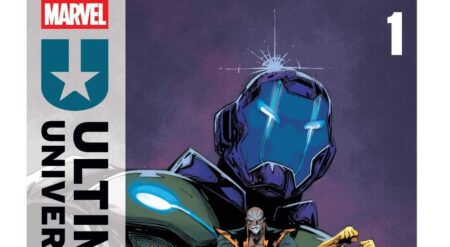
Miles Morales: Spider-Man #25 is written by Saladin Ahmed, illustrated by Carmen Carnero, colored by David Curiel, and lettered by VC’s Cory Petit. It is published by Marvel Comics. The “Clone Saga” story begins when Miles Morales learns that a Spider-Man resembling him has been assaulting scientists across New York. With the help of Peter Parker, the Amazing Spider-Man, Miles discovers that there are three clones of him causing chaos — each with their own different superpower.
The words “Clone Saga” are rather contentious where Spider-Man is concerned. The original Clone Saga, though it introduced a fan-favorite character in the form of Ben Reilly/Scarlet Spider, it is also derided for stretching far past its intended length and having a payoff that wasn’t worth the setup. Thankfully, this “Clone Saga” works, as it is grounded in emotion first and foremost, thanks to Ahmed’s stellar scripting and Carnero’s dynamic artwork. Ahmed, in particular, has been building up this storyline throughout the pages of previous issues of Miles Morales: Spider-Man.
In addition to the clone problem, Ahmed throws multiple emotional bombs in Miles’s path—a sharp detour from the previous issue, which saw him and Kamala Khan blowing off steam after the events of King in Black. Not only is there a development that rocks his relationship with his best friend Ganke, but he is also forced to face his potential anger issues. Granted, Miles has every right to be angry as someone’s stolen his DNA—the core of his very being—and perverted it. But with his strength, he could potentially hurt someone. His inner monologue, which is reflected as entries in his journal, delves deep into this anguish and has Miles wondering if all the fighting he does makes him a bad person. Something I’ve always appreciated throughout the series is how Petit presents Miles’s “journal entries” as actual scraps of paper; it feels like Miles is actually writing his thoughts down.
Carnero and Curiel debut Miles’s trio of clone “brothers” in this issue, and they are utterly horrifying. One clone is a massive pile of shifting flesh, and Carnero depicts him as literally “sagging.” His earlobes are the worst of this, as they look like flesh-colored ropes. Another clone looks like an actual spider, with six spindly legs and a misshapen, multi-eyed head. And finally, the lead clone Selim has twin blades that appear to be welded to his hands. It further adds to Miles’s rage that his DNA has more or less been taken against his will and used to create monsters. Adding to the horror vibe of the issue, the entire issue takes place at night. Curiel uses appropriately muted colors, except in the case of Peter as his vibrant red-and-blue suit makes him stand out from the other Spider-Men. Miles’s trademark red and black, on the other hand, looks outright menacing.
The issue contains a bonus story, “Big Time Buzzkill,” which is written by Cody Ziglar, illustrated by Natacha Bustos, and colored by Rachelle Rosenberg. It centers around Miles’s attempts to get a birthday cake for his friend Judge until he runs into a bee-themed villain named the Bumbler. Bustos and Rosenberg give this story a nice, vibrant look that makes it feel like an animated short and provides a perfect contrast to the heavy themes presented in the main story. Also, the Bumbler has to be one of the most inventive D-list villains I’ve seen in a comic.t The guy has literal honey bombs as weapons!
Miles Morales: Spider-Man #25 puts its own spin on a controversial Spider-Man storyline, opting to ground its action and story in emotion. The payoff for this storyline is well worth the buildup, and I hope that Miles can emerge victorious from this latest conflict.
Miles Morales: Spider-Man #25 is available wherever comics are sold.
Spider-Man: Miles Morales #25
TL;DR
Miles Morales: Spider-Man #25 puts its own spin on a controversial Spider-Man storyline, opting to ground its action and story in emotion. The payoff for this storyline is well worth the buildup, and I hope that Miles can emerge victorious from this latest conflict.






